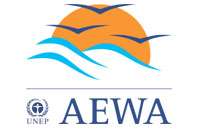Agreement on the Conservation of African-Eurasian Migratory Waterbirds
| The Agreement on the Conservation of African-Eurasian Migratory Waterbirds | |
|---|---|
 Official Logo | |
| Context | Conservation |
| Drafted | 16 June 1995 |
| Location | The Hague |
| Effective | 1 November 1999 |
| Parties |
African – 26
Eurasia – 39
|
| Depositary | Government of The Netherlands |
The Agreement on the Conservation of African-Eurasian Migratory Waterbirds, or African-Eurasian Waterbird Agreement (AEWA) is an independent international treaty developed under the auspices of the United Nations Environment Programme's Convention on Migratory Species. It was founded to coordinate efforts to conserve bird species migrating between European and African nations, and its current scope stretches from the Arctic to South Africa, encompassing the Canadian archipelago and the Middle East as well as Europe and Africa.
The agreement focuses on bird species that depend on wetlands for at least part of their lifecycle and cross international borders in their migration patterns. It currently covers 254 species.[1]
Parties
| Region | Party Name | Date in Force |
|---|---|---|
| Africa | Benin | 2000-1-01 |
| Africa | Mali | 2000-1-01 |
| Africa | Uganda | 2000-12-01 |
| Eurasia | Denmark | 2000-1-01 |
| Eurasia | Finland | 2000-1-01 |
| Eurasia | Bulgaria | 2000-2-01 |
| Eurasia | Macedonia | 2000-2-01 |
| Eurasia | Croatia | 2000-9-01 |
| Eurasia | Romania | 2000-10-01 |
| Africa | Mauritius | 2001-1-01 |
| Africa | Kenya | 2001-6-01 |
| Eurasia | Moldova | 2001-4-01 |
| Eurasia | Slovakia | 2001-7-01 |
| Eurasia | Georgia | 2001-8-01 |
| Eurasia | Albania | 2001-9-01 |
| Africa | South Africa | 2002-4-01 |
| Eurasia | Israel | 2002-11-01 |
| Eurasia | Lebanon | 2002-12-01 |
| Africa | Equatorial Guinea | 2003-1-01 |
| Eurasia | Ukraine | 2003-1-01 |
| Eurasia | Hungary | 2003-3-01 |
| Eurasia | Ireland | 2003-8-01 |
| Eurasia | Syria | 2003-8-01 |
| Eurasia | Slovenia | 2003-10-01 |
| Eurasia | France | 2003-12-01 |
| Eurasia | Luxembourg | 2003-12-01 |
| Africa | Djibouti | 2004-3-01 |
| Africa | Nigeria | 2004-7-01 |
| Eurasia | Portugal | 2004-3-01 |
| Eurasia | Uzbekistan | 2004-4-01 |
| Eurasia | Lithuania | 2004-11-01 |
| Africa | Libya | 2005-6-01 |
| Africa | Tunisia | 2005-7-01 |
| Africa | Ghana | 2005-10-01 |
| Eurasia | European Union | 2005-10-01 |
| Africa | Algeria | 2006-10-01 |
| Africa | Guinea-Bissau | 2006-11-01 |
| Eurasia | Latvia | 2006-1-01 |
| Eurasia | Belgium | 2006-6-01 |
| Eurasia | Czech Republic | 2006-9-01 |
| Eurasia | Italy | 2006-9-01 |
| Africa | Madagascar | 2007-1-01 |
| Eurasia | Norway | 2008-9-01 |
| Eurasia | Cyprus | 2008-9-01 |
| Eurasia | Estonia | 2008-11-01 |
| Africa | Ethiopia | 2010-2-01 |
| Africa | Chad | 2011-11-01 |
| Eurasia | Montenegro | 2011-11-01 |
| Africa | Congo | 1999-11-01 |
| Africa | Egypt | 1999-11-01 |
| Africa | Gambia | 1999-11-01 |
| Africa | Guinea | 1999-11-01 |
| Africa | Niger | 1999-11-01 |
| Africa | Senegal | 1999-11-01 |
| Africa | Sudan | 1999-11-01 |
| Africa | Togo | 1999-11-01 |
| Africa | Tanzania | 1999-11-01 |
| Eurasia | Germany | 1999-11-01 |
| Eurasia | Jordan | 1999-11-01 |
| Eurasia | Monaco | 1999-11-01 |
| Eurasia | Netherlands | 1999-11-01 |
| Eurasia | Spain | 1999-11-01 |
| Eurasia | Sweden | 1999-11-01 |
| Eurasia | Switzerland | 1999-11-01 |
| Eurasia | United Kingdom | 1999-11-01 |
Meetings
The Parties meet every few years. So far there have been five meetings, with a sixth to occur late in 2015: 7–9 November 1999 in Cape Town, South Africa; 25–27 September 2002 in Bonn, Germany; 23–27 October 2005 in Dakar, Senegal; 15–19 September 2008 in Antananarivo, Madagascar; 14–18 May 2012 in La Rochelle, France. 9-14 November 2015 in Bonn, Germany
Treaties
Ban on lead shot
The use of lead shot over wetlands has been banned by the signatories to the convention on account of the poisoning it causes.[2][3]
See also
References
- ↑ http://aewa.eaudeweb.ro/en/species
- ↑ "Protecting Waterfowl From Lead in Wetlands: A Practical Guide to the Lead Shot Regulations in Northern Ireland" (pdf). Ireland: Countryside Alliance. 24 April 2009. Retrieved 24 March 2013.
- ↑ "Phasing Out The Use of Lead Shot For Hunting in Wetlands: Experiences Made and Lessons Learned By AEWA Range States" (pdf). AEWA. 5 November 2009: 3. Retrieved 25 March 2013.